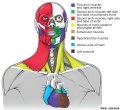File:Head and heart muscle cartoon.jpg: Difference between revisions
mNo edit summary |
mNo edit summary |
||
| Line 1: | Line 1: | ||
==Head and | ==Head and Heart Muscle== | ||
The head includes at least six different muscle groups, all arising from the cardiopharyngeal field and being branchiomeric, except the hypobranchial and perhaps the extraocular muscles. On the left side of the body (right part of figure) the facial expression muscles have been removed to show the masticatory muscles. | |||
The six groups are: | |||
# first/mandibular arch muscles, including cells clonally related to the right ventricle | |||
# left second/hyoid arch muscles related to myocardium at the base of the pulmonary trunk | |||
# right second/hyoid arch muscles, related to myocardium at the base of the aorta | |||
# muscles of the most posterior pharyngeal arches, including muscles of the pharynx and larynx and the cucullaris-derived neck muscles trapezius and sternocleidomastoideus | |||
# extraocular muscles, which are often not considered to be branchiomeric, but according to classic embryological studies and recent retrospective clonal analyses in mice contain cells related to those of the branchiomeric mandibular muscles | |||
# hypobranchial muscles, including tongue and infrahyoid muscles that derive from somites and migrate into the head and neck | |||
===Reference=== | ===Reference=== | ||
| Line 6: | Line 15: | ||
====Copyright==== | ====Copyright==== | ||
Reprinted by permission from Macmillan Publishers Ltd: [NATURE] (doi:10.1038/nature14435), copyright (2015) | |||
http://s100.copyright.com/CustomerAdmin/PLF.jsp?ref=c15c3b41-4704-4662-99fb-64efe8067669 | |||
{{Footer}} | {{Footer}} | ||
Revision as of 23:36, 3 August 2016
Head and Heart Muscle
The head includes at least six different muscle groups, all arising from the cardiopharyngeal field and being branchiomeric, except the hypobranchial and perhaps the extraocular muscles. On the left side of the body (right part of figure) the facial expression muscles have been removed to show the masticatory muscles.
The six groups are:
- first/mandibular arch muscles, including cells clonally related to the right ventricle
- left second/hyoid arch muscles related to myocardium at the base of the pulmonary trunk
- right second/hyoid arch muscles, related to myocardium at the base of the aorta
- muscles of the most posterior pharyngeal arches, including muscles of the pharynx and larynx and the cucullaris-derived neck muscles trapezius and sternocleidomastoideus
- extraocular muscles, which are often not considered to be branchiomeric, but according to classic embryological studies and recent retrospective clonal analyses in mice contain cells related to those of the branchiomeric mandibular muscles
- hypobranchial muscles, including tongue and infrahyoid muscles that derive from somites and migrate into the head and neck
Reference
<pubmed>25903628</pubmed>
Copyright
Reprinted by permission from Macmillan Publishers Ltd: [NATURE] (doi:10.1038/nature14435), copyright (2015)
http://s100.copyright.com/CustomerAdmin/PLF.jsp?ref=c15c3b41-4704-4662-99fb-64efe8067669
Cite this page: Hill, M.A. (2024, April 20) Embryology Head and heart muscle cartoon.jpg. Retrieved from https://embryology.med.unsw.edu.au/embryology/index.php/File:Head_and_heart_muscle_cartoon.jpg
- © Dr Mark Hill 2024, UNSW Embryology ISBN: 978 0 7334 2609 4 - UNSW CRICOS Provider Code No. 00098G
File history
Click on a date/time to view the file as it appeared at that time.
| Date/Time | Thumbnail | Dimensions | User | Comment | |
|---|---|---|---|---|---|
| current | 23:31, 3 August 2016 |  | 874 × 800 (129 KB) | Z8600021 (talk | contribs) | PMID 25903628 |
You cannot overwrite this file.
File usage
The following page uses this file: